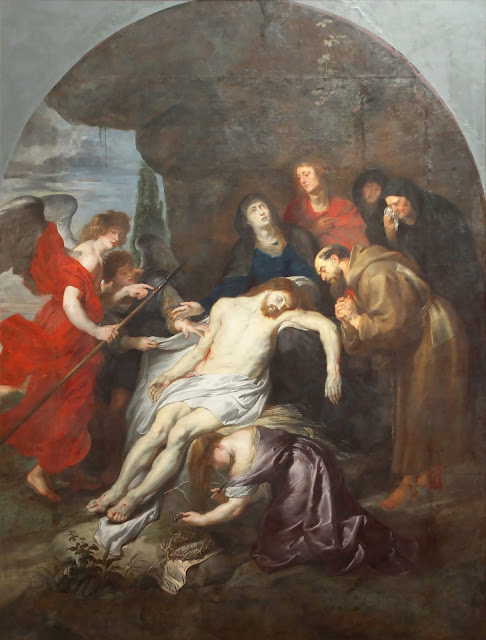Pieta with Saint Francis by Paul Rubens
The body of Christ lies stretched out on a straw-covered stone at the entrance to a grotto, his left shoulder supported by Mary’s knee. Next to them stands St. Francis, with red-rimmed eyes and stigmata. Behind the Virgin, withdrawn in the shadow of the grotto, are St. John and the two Marys.
In the foreground, the kneeling Mary Magdalene, whose hair has fallen forward, leaving her neck and shoulders bare, reaches out to snatch up two nails from the cross. Two other nails are lying on the ground with the crown of thorns and the titulus, ‘Jesus of Nazareth, king of the Jews,’ written in Aramaic, Greek and Latin.
Two angels are entering the grotto. One, draped in red and armed with a bloodied lance, confronts the faithful viewer with the suffering of Christ; his companion bends forward to touch the wound in His side, the focus of a special devotion among the Franciscans.
The painting is a devotional image designed to stimulate contemplation and imitation of the suffering of Christ (imitatio Christi).
It gives expression to two fundamental elements of Tridentine doctrine. The fi gures all incline toward Christ’s body and thereby participate in the Eucharist through Communion, the actual and spiritual receiving of bread and wine as Christ’s body and blood. The altarpiece was painted between 1617 and 1620 and was used as the main altar of the no longer extant Brussels Capuchin church, which was dedicated to St. Francis of Assisi. The church and its decoration were largely subsidized by the Arenberg family, with whom Rubens had served as a page in his youth.
The altar of St. Francis was fi nanced by Prince Alexander of Arenberg-Croÿ-Chimay (1590- 1629). In Capuchin devotion, the asceticism of St. Francis played an important role because the saint experienced the pain of the crucifi xion by virtue of his faith and therefore followed in the footsteps of Christ.
Technical analysis of the support shows that Rubens and his assistants began painting an initial version of the composition that was narrower and closer to the design of the painted sketch. At some point in the process of execution, the scene was enlarged on strips of canvas that were added to the sides and below.
The relatively dark preparatory layer is visible through the abraded, gray-toned layers of paint. The composition is contained within a circle with its center around the region of Christ’s heart. As in the Album amicorum of Filips van Valckenisse and the Coronation of the Virgin, Rubens emphasizes the holiness and perfection of the figures depicted. Infrared relectography shows that the saint originally wore sandals, but that they were later removed in order to emphasize his ascetic, penitent character, which was more in line with Capuchin ideals.
The painting appears to be primarily the work of an assistant who had diffi culties with the convincing depiction of human anatomy and attempted to cover up his weak, uncertain touch by strengthening the outline of the limbs with heavy contours. Exaggerated cleaning has damaged the layers of paint, which were once praised by Bellori for their depiction of light and shadow.8
In addition, numerous instances of overpainting make it particularly diffi cult to carry out a stylistic analysis and identify the ‘retouches’ of the master.
Get 4 restored images (including the one on this post), now on sale
This image is a public domain image, which means either that copyright has expired in the image or the copyright holder has waived their copyright. Franciscan Gallery charges for the access to high resolution copy of the image. Manually restoration was necessary in order to improve quality, without covering the original image.





Comments
Post a Comment